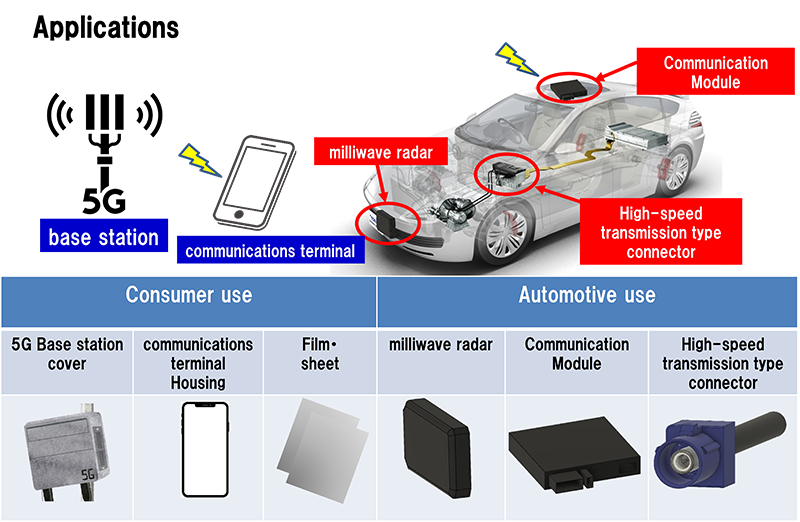Toray Develops Low-Dielectric-Loss PBT for 5G Communications, Automated Driving and Intelligent Transportation Systems Applications
Tokyo, Japan, July 13, 2021 – Toray Industries, Inc., announced today that it has developed a high-performance polybutylene terephthalate (PBT) (see Glossary note 1) whose dielectric losses (note 2) in the high-frequency millimeter wave band are around 40% lower than those of conventional PBT without compromising dimensional stability and moldability. The new offering product should significantly enhance the performances of high-speed transmission connectors, communication modules, millimeter wave radars, and other equipment for 5G base stations and automated driving systems.
The company looks to initiate full-fledged sample work to meet demand for materials used in 5G communication materials. It will develop applications for advanced driver-assistance systems (note 3) and intelligent transportation systems (note 4) for automated driving setups.
Applications for PBT include automotive, electrical, and electronic parts. This reflects its outstanding balance of dimensional stability, strength, and other performance elements. It is also easy to mold and process. There has been a growing need in recent years to lower dielectric losses and thereby cut transmission losses in high-frequency components for automated driving and other applications. This has led to the adoption of polymer alloys (note 5) and fillers. There are limits to reducing dielectric losses, however, as such losses from the resin itself are large. Other issues are heat resistance and mechanical property degradation.
Toray’s PBT delivers a loss tangent (note 6) of 0.006 in the ultra-wide 79 GHz millimeter wave band. Losses from that factor are around 40% below those of conventional PBT resins while retaining their basic properties. That is because the company constrained the polymer’s molecular motion in the high-frequency range by leveraging polymerization technology to attain a new structure.
The new offering keeps the dielectric loss low across 5G communication frequency bands, from sub-6 GHz through high-frequency millimeter wave bands. Dielectric stability is superb in very hot and humid environments. It cuts transmission losses and enables wide-area sensing for incident waves from wide angles, which is an issue in designing high-frequency components.
It has been challenging to downsize products without changing the electrical resistance of electric circuits and connectors. The low dielectric loss of Toray’s new resin makes it possible to keep electrical resistance unchanged, which should contribute to shrinking products, reducing weight, and improving performance.
Toray has commercialized a range of 5G-suitable resins, and will promote its new offering for use in semiconductor devices and electronic components to support advanced communication technologies. The company will keep developing revolutionary materials that contribute to social progress in line with its commitment to innovating ideas, technologies, and products that deliver new value.
The company looks to initiate full-fledged sample work to meet demand for materials used in 5G communication materials. It will develop applications for advanced driver-assistance systems (note 3) and intelligent transportation systems (note 4) for automated driving setups.
Applications for PBT include automotive, electrical, and electronic parts. This reflects its outstanding balance of dimensional stability, strength, and other performance elements. It is also easy to mold and process. There has been a growing need in recent years to lower dielectric losses and thereby cut transmission losses in high-frequency components for automated driving and other applications. This has led to the adoption of polymer alloys (note 5) and fillers. There are limits to reducing dielectric losses, however, as such losses from the resin itself are large. Other issues are heat resistance and mechanical property degradation.
Toray’s PBT delivers a loss tangent (note 6) of 0.006 in the ultra-wide 79 GHz millimeter wave band. Losses from that factor are around 40% below those of conventional PBT resins while retaining their basic properties. That is because the company constrained the polymer’s molecular motion in the high-frequency range by leveraging polymerization technology to attain a new structure.
The new offering keeps the dielectric loss low across 5G communication frequency bands, from sub-6 GHz through high-frequency millimeter wave bands. Dielectric stability is superb in very hot and humid environments. It cuts transmission losses and enables wide-area sensing for incident waves from wide angles, which is an issue in designing high-frequency components.
It has been challenging to downsize products without changing the electrical resistance of electric circuits and connectors. The low dielectric loss of Toray’s new resin makes it possible to keep electrical resistance unchanged, which should contribute to shrinking products, reducing weight, and improving performance.
Toray has commercialized a range of 5G-suitable resins, and will promote its new offering for use in semiconductor devices and electronic components to support advanced communication technologies. The company will keep developing revolutionary materials that contribute to social progress in line with its commitment to innovating ideas, technologies, and products that deliver new value.
| An application of Toray’s low-dielectric-loss PBT resin |
 |
Glossary
- 1.Polybutylene terephthalate offers excellent long-term thermal, chemical, and weather resistance and electrical characteristics.
- 2.A dielectric loss is an energy loss caused by the conversion of electromagnetic wave energy into heat in a material.
- 3.Advanced driver-assistance systems employ various sensors to assess surrounding conditions, inform and warn to drivers, and modify steering wheel and brake control to enhance safety for all road users.
- 4.Intelligent transport systems manage information on people, roads, and automobiles to help reduce accidents, congestion, and environmental impact.
- 5.Polymer alloys are performance-enhancing polymer blends.
- 6.The loss tangent indicates the extent of dielectric losses.


